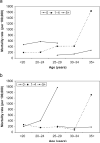Risk factors for pregnancy-related mortality: a prospective study in rural Nepal
- PMID: 17826810
- PMCID: PMC2367232
- DOI: 10.1016/j.puhe.2007.06.003
Risk factors for pregnancy-related mortality: a prospective study in rural Nepal
Abstract
Objectives: This study examined the risk factors of mortality related to pregnancy for the first year post partum in a cohort of 25,580 pregnancies.
Study design: Longitudinal cohort follow-up.
Methods: Details of socio-economic status, mid-upper arm circumference (MUAC), diet, illness, work, substance use and previous pregnancy history were collected during early to mid-gestation, and these women were followed for 1 year post partum. All-cause mortality rates per 100,000 pregnancies were calculated for deaths during pregnancy or up to 42 days post partum (early period) and 43-364 days post partum (late period). Odds ratios (OR) of mortality were estimated using five groups of risk factors: biological; morbidity; dietary; lifestyle; and socio-economic. Significant factors within each group were included in a single risk model for each time period.
Results: Early and late pregnancy-related mortality rates were 469 [95% confidence interval (CI) 385-553] and 254 (95% CI 192-316), respectively. Maternal age > or = 35 years was associated with a three- to four-fold increase in mortality, whereas increasing parity conferred increasing protection. In the final model, a larger MUAC and consumption of dark green leaves were associated with decreased risk of death in the early period (OR 0.76, 95% CI 0.67-0.87 and 0.64, 95% CI 0.41-0.99, respectively). A larger MUAC was also associated with a lower risk of death in the late period. Diarrhoea/dysentery and pre-eclampsia were associated with increased risk of death in the early period (OR 2.78, 95% CI 1.40-5.51 and 2.95, 95% CI 1.48-5.90, respectively). Factors weakly associated (P<0.1) with mortality in both periods included night blindness, strenuous work activity and cigarette smoking. No socio-economic factors were significant in the models.
Conclusions: Maternal age, parity, MUAC, diet and illness in early to mid-gestation were associated with risk of death during pregnancy and the first year post partum in rural Nepal.
Figures
References
-
- World Health Organization and UNICEF . Estimates of maternal mortality. World Health Organization and UNICEF; Geneva: 1996. [Revised 1990]
-
- Graham WJ. Now or never: the case for measuring maternal mortality. Lancet. 2002;359:701–4. - PubMed
-
- Buor D, Bream K. An analysis of the determinants of maternal mortality in sub-Saharan Africa. J Women Health. 2004;13:926–38. - PubMed
Publication types
MeSH terms
Grants and funding
LinkOut - more resources
Full Text Sources


